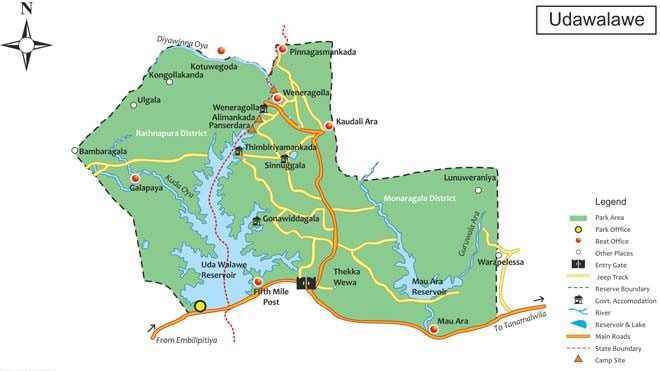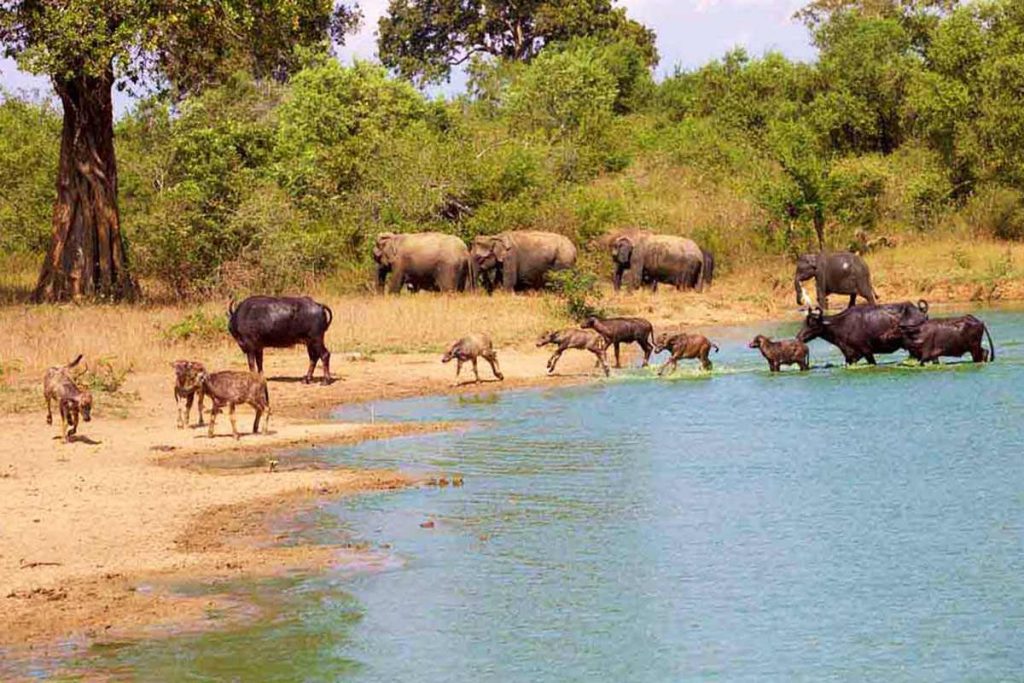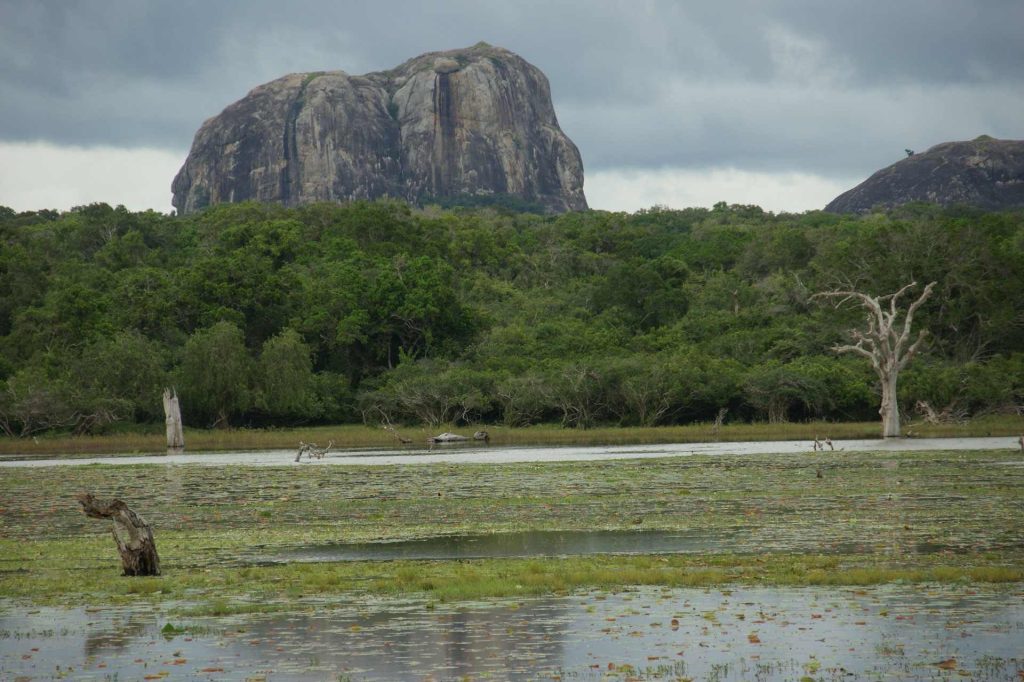Udawalawe National Park, a fascinating destination in Sri Lanka, offers the chance to observe a wide variety of wildlife and enjoy vast plains amidst the tranquility of nature. Known as one of the best places in the country to see elephants in their natural habitat, Udawalawe also hosts many other species, making every visit an unforgettable experience. Follow this complete guide to make the most of your trip, from how to get there to the best activities and recommended sites. Get ready for an unforgettable adventure in the heart of Sri Lanka’s wildlife!
Content
- 1 Information about Udawalawe National Park
- 2 How to Get to Udawalawe National Park
- 3 Geography of Udawalawe National Park
- 4 Geography of Udawalawe
- 5 Flora of Udawalawe National Park
- 6 Fauna of Udawalawe National Park
- 7 Recommended Excursions and Activities
- 8 What to See and Do in Udawalawe National Park
- 9 Gastronomy in the Udawalawe Area
- 10 Accommodations in Udawalawe
Information about Udawalawe National Park
History
Udawalawe National Park was established on June 30, 1972, with the primary goal of providing a sanctuary for wildlife displaced by the construction of the Udawalawe Reservoir, located on the Walawe River. The park spans a vast area of 30,821 hectares (119 square miles), not only protecting the reservoir basin but also offering a safe refuge for many species that inhabit the area.
Before its designation as a national park, the region was used for migratory or chena farming. However, with the park’s declaration, farmers were gradually relocated to ensure the area’s conservation. Located 165 kilometers from Colombo, Udawalawe has grown in significance as a habitat for waterbirds and is especially renowned for its population of Sri Lankan elephants.
Today, Udawalawe is recognized as one of the most visited parks in the country, not only because of its proximity to several major cities but also due to the opportunities it offers to witness large groups of elephants throughout the year. This combination of easy access and impressive biodiversity makes it a prominent wildlife tourism destination in Sri Lanka.
Location
Udawalawe National Park is located in southern Sri Lanka, about 4–5 hours by car from the capital, Colombo. It spans the provinces of Sabaragamuwa and Uva, offering a wide variety of landscapes, from dry plains to rivers and low hills. The park’s location makes it an excellent choice for those wanting to explore wildlife without straying too far from other tourist attractions.
Best Time to Visit Udawalawe
The best time to visit Udawalawe is during the dry season, typically from May to September. During this period, animals gather near water sources, making them easier to spot. However, the park is accessible and offers wildlife sightings year-round, making it an ideal destination in any season.
How to Get to Udawalawe National Park
From Colombo
The most common way to travel from Colombo to Udawalawe is by car or taxi, which takes about 4–5 hours. Alternatively, you can take a bus to Embilipitiya and then use local transport to reach the park.
From Galle
From Galle, Udawalawe can be reached in about 3–4 hours by car or taxi. The route is scenic, passing through rural areas and tea plantations.
From Kandy
The journey from Kandy to Udawalawe takes approximately 5 hours by car. This is a popular option for those looking to combine a visit to the park with an experience in Sri Lanka’s highlands.
From Hambantota
From Hambantota, the trip to Udawalawe is relatively short, taking around 1–1.5 hours, making it an excellent day trip option if you are in the southern region of the island.
Geography of Udawalawe National Park
The landscape of Udawalawe National Park is a mix of open grasslands, shrub forests, and marshy areas near the reservoir. This diversity of habitats provides an ideal home for a variety of species, both large and small. The Udawalawe Reservoir, at the center of the park, is one of the main attractions and a key spot for animal sightings.
Geography of Udawalawe
The landscape of Udawalawe National Park presents a unique combination of open grasslands, shrub forests, and marshy areas near the reservoir, creating a rich diversity of habitats that support a wide variety of species. The Udawalawe Reservoir, located at the heart of the park, is one of the main attractions and a key spot for wildlife sightings. This reservoir is not only vital for the fauna but also provides a crucial water source for the region.
Situated at the boundary between Sri Lanka’s wet and dry zones, the park is primarily dominated by plains, although some mountainous areas add variety to the landscape. The Kalthota Mountain Range and Diyawini Falls to the north, along with the rocky outcrops of Bambaragala and Reminikotha within the park, provide a fascinating geographical setting. With an annual rainfall of approximately 1,500 millimeters, most precipitation occurs between October and January and from March to May, while the average annual temperature is around 27–28°C (81–82°F). Relative humidity ranges from 70% to 83%, contributing to the variety of ecosystems present in the park.
The park’s soil varies by location, with well-drained reddish-brown soils in most areas, while the valleys feature humic gray soils, which are less drained. Areas near the Walawe River and its tributaries, as well as the marshlands surrounding the reservoir, provide rich habitats for both aquatic and terrestrial species. The dead trees protruding from the reservoir serve as a visible reminder of the extensive forest that once covered the area before the construction of the dam.
In addition to the grasslands, which are abundant due to past agricultural practices, the park features a teak plantation south of the dam, established before Udawalawe was designated as a national park. In terms of biodiversity, Udawalawe hosts 94 plant species, 21 fish species, 12 amphibian species, 33 reptile species, 184 bird species (33 of which are migratory), and 43 mammal species. Additionally, 135 butterfly species have been recorded among the many invertebrates found in the park. These geographical and ecological characteristics make Udawalawe a vital conservation area and an attractive destination for nature enthusiasts.
Flora of Udawalawe National Park
The park is characterized by areas of shrubs, grasslands, and scattered trees, creating an ideal habitat for wildlife thriving in savanna and scrubland zones. Notable tree species include teak and acacias, which provide shade and shelter for many animal species, including elephants.
The park also boasts a rich diversity of floral species, including several endemic plants. These include *Hopea cordifolia*, which grows along the river, accompanied by *Terminalia arjuna* and species like *Memecylon petiolatum*, *Erythroxylon zeylanicum*, and *Jasminum angustifolium*, all endemic to the region.
Grasslands are particularly crucial for the fauna, with species such as *Panicum maximum* and *Imperata cylindrica* serving as essential food sources for elephants. Additionally, the landscape is adorned with tall trees commonly found in the park, such as *Chloroxylon swietenia*, *Berrya cordifolia*, *Diospyros ebenum*, *Adina cordifolia*, *Vitex pinnata*, *Schleichera oleosa*, and *Diospyros ovalifolia*.
Besides its ecological value, the park is home to plant species with medicinal properties, such as *Terminalia bellirica* and *Phyllanthus emblica*, highly valued in traditional medicine. Shrubs like *Grewia tiliifolia* and grasses like *Cymbopogon confertiflorus* further enhance the rich botanical diversity of Udawalawe.
Fauna of Udawalawe National Park
Elephants of Udawalawe
Udawalawe is renowned for its large population of Sri Lankan elephants, with a herd of approximately 250 elephants permanently residing in the park. The Udawalawe Reservoir is a major attraction for these animals, often seen grazing or cooling off near the water. Overall, the park is estimated to host around 500 elephants. To care for orphaned or abandoned elephants, the Udawalawe Elephant Transit Home was established in 1995. This center rehabilitates young elephants before releasing them back into their natural habitat once they are strong enough to survive on their own.
Other Mammals
In addition to elephants, Udawalawe is home to other mammals. These include the axis deer, Sri Lankan sambar deer, Indian muntjac, and wild boar, which are easily spotted during a safari. Water buffalo, with their mighty horns, are also a highlight of the park. Although more elusive, the park is also home to members of the feline family, such as the rusty-spotted cat, fishing cat, and Sri Lankan leopard. Another resident, though rarely seen, is the Sri Lankan sloth bear.
Smaller mammals in the park include the golden jackal, Asian palm civet, and toque macaque. Rodent populations are well-represented, with endemic species such as the Ceylon spiny mouse, also found in Yala National Park. Various mongoose species, including the Indian mongoose, have also been recorded in Udawalawe.
Birds and Aquatic Biodiversity
The park is a paradise for birdwatchers, with over 180 species recorded, including several endemic species. Some of the most notable birds include the Sri Lankan junglefowl, red-faced malkoha, Sri Lankan grey hornbill, and brown-headed barbet. The Udawalawe Reservoir attracts many aquatic birds, such as painted storks, cormorants, the spot-billed pelican, Asian openbill, and black-headed ibis. During migration seasons, birds like the white wagtail and black-headed kingfisher can also be observed in the park.
Udawalawe is also known for attracting various raptors, including the grey-headed fish eagle, booted eagle, and migratory osprey. Terrestrial birds are abundant as well, with species such as the Indian roller, Indian peafowl, and Malabar pied hornbill frequently seen.
Reptiles and Fish
Udawalawe boasts an impressive diversity of reptiles, including the saltwater crocodile and the Asian water monitor, as well as various snake species, both venomous and non-venomous. Common lizards, such as the oriental garden lizard and the painted-lip lizard, are also easy to spot during a walk in the park.
In the park’s water bodies, including the Udawalawe Reservoir, both endemic and introduced fish species can be found. Among the endemic species is Garra ceylonensis, while introduced species like Oreochromis spp., giant gourami, catla, and rohu are common and play an important role in local fishing.
Recommended Excursions and Activities
What to See and Do in Udawalawe National Park
Udawalawe Reservoir
The reservoir is one of the park’s main attractions, not only for its scenic beauty but also as a gathering point for many animal species, especially during the dry season.
Udawalawe Elephant Transit Home
Located on the outskirts of the park, this conservation center is dedicated to rehabilitating orphaned elephant calves. Visitors can observe feeding sessions and learn about conservation efforts in the region.
Popular Safari Routes
Morning and evening safaris are the most popular, as these are the times when animals are most active. These routes allow visitors to venture into the park’s more remote areas, where larger numbers of wildlife can be spotted.
Birdwatching Zones
For bird enthusiasts, areas near the reservoir and wetlands are prime spots for observing both resident and migratory species.
Sunsets at the Reservoir
Sunsets at the reservoir are spectacular. Visitors can enjoy breathtaking views as animals come to drink water, creating an unforgettable scene.
Wildlife Photography
With its abundance of animals and stunning landscapes, Udawalawe is an ideal place for wildlife photography. The 4×4 safaris provide numerous opportunities to capture unique images of elephants, birds, and other animals.
4×4 Vehicle Safaris
Exploring the park in off-road vehicles is the best way to experience it. These tours take visitors through open plains and forested areas, offering multiple opportunities to see elephants, buffalo, and birds in their natural habitat.
Birdwatching
With binoculars in hand, bird lovers can enjoy spotting rare and exotic species. The areas near the reservoir and wetlands are the best places to observe a variety of waterbirds.
Guided Nature Walks
Some tour operators offer guided nature walks around the park, allowing visitors a closer and more tranquil experience of the local flora and fauna.
Gastronomy in the Udawalawe Area
Traditional Sri Lankan Cuisine
In the areas surrounding the park, visitors can enjoy traditional Sri Lankan dishes such as rice and curry, coconut sambol, and dishes based on fresh fish.
Local Fish and Seafood
Nearby rivers and reservoirs provide fresh fish, which is served in local restaurants as part of the region’s typical cuisine.
Rice and Curry Dishes
Rice and curry is the staple dish throughout Sri Lanka, and Udawalawe is no exception. Visitors can try different versions of this dish at local restaurants.
Accommodations in Udawalawe
Nearby Hotels and Resorts
Around Udawalawe, you can find a variety of hotels and resorts offering luxury and comfort. Nearby towns like Udawalawe Town and Sevanagala have accommodations with quick access to the park, many of which offer views of the surrounding landscape.
Eco-Lodges and Nature Retreats
For those seeking a closer connection to nature, several eco-lodges are situated around Udawalawe. These sustainable accommodations, located in areas like Thanamalwila and Weli Oya, offer the opportunity to enjoy the serene natural environment of the park. Eco-lodges are often constructed using eco-friendly materials and offer activities such as guided walks and eco-safaris, providing a more intimate experience with local flora and fauna.
Other Options in Embilipitiya
The town of Embilipitiya, about a 20-minute drive from the park, offers a wide range of accommodations, from budget hotels to mid-range establishments. This town is ideal for those who prefer a greater variety of services without being too far from Udawalawe. Visitors can find hotels with modern amenities, small hostels, and guesthouses that provide a comfortable and convenient stay at affordable prices. Embilipitiya also has a good selection of restaurants and local markets, making it an excellent base for exploring the region.
Next recommended parks: Sri Lanka National Parks.



